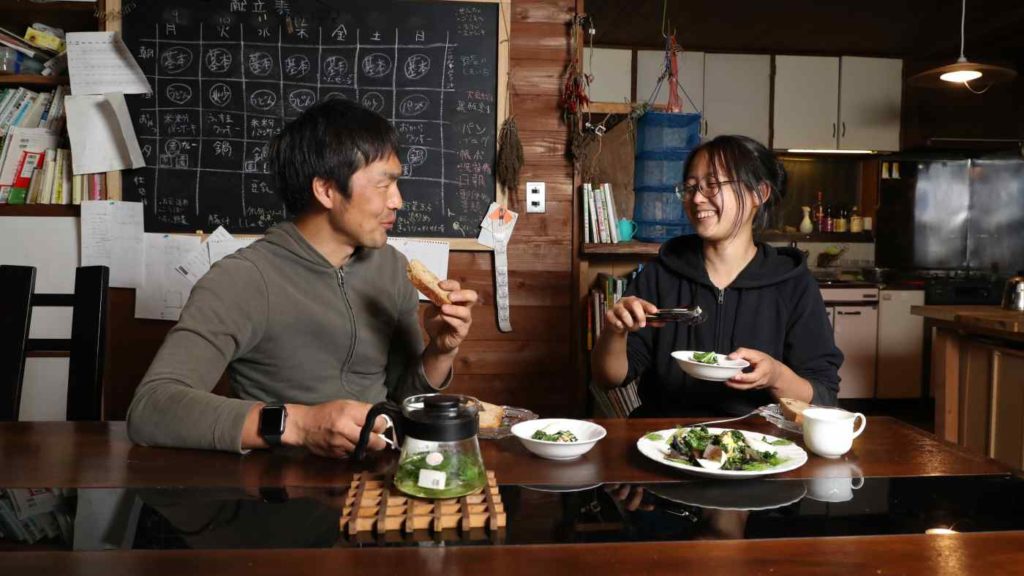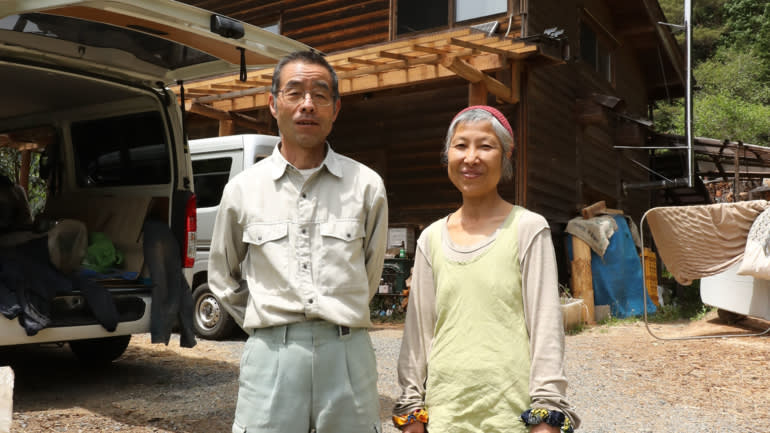Now he is the owner of a minshuku, a small family-run inn, in Tokigawa, a rural town of 10,000 people in a hilly region of Saitama. Kaneko and his partner, Yuka Abe, 28, manage the minshuku, Rakuya, nestled in a forest with few neighbors around.
The couple is trying to be as self-sufficient as possible without making too much effort to do so. They grow many of the vegetables they eat and make various tools and other daily items they need. But they have no strict rules about their self-sufficiency, nor have any desire to lead a reclusive life. They just want to keep their lives as stress-free as possible.
Many Japanese, exhausted from working long hours and managing workplace relationships, yearn for a more relaxed lifestyle that does not require worrying about deadlines and job performance.
Kaneko and Abe show us how we could enjoy such a life through self-sufficient living and small-scale farming.
When it comes to self-sufficient living, people would wonder how many kinds of foodstuff they actually produce themselves so they do not have to buy them. The variety was surprisingly large.
They are self-sufficient in eggs, as the five hens they keep in the garden each lay one egg every day. They also grow sufficient soybeans, tomatoes, eggplants, daikon radishes, ginger and carrots, as well as rice and wheat, to feed themselves. For long-term storage, they make soybean flour, tomato and eggplant puree, dried radishes and ginger, and pickled carrots. They also make udon noodles and bread from their wheat, which is ground into flour at a mill. In addition, they eat wild herbs growing in their garden such as sugina (field horsetail), yomogi (Japanese mugwort) and dokudami (Houttuynia cordata).

After graduating from university, Kaneko worked for a company and an accounting firm for a while before he started pursuing a career as a cook. He learned how to use Japanese hocho knives at a sushi restaurant and prepared breakfasts at a hotel in Australia before getting involved in the launch of a cafe in Hong Kong.
During these hardworking days, he put in as many as 17 hours a day. But the years of hard labor began to take a heavy toll on his health. A doctor told him that the job would eventually kill him.
Kaneko’s desire to live in a natural environment grew to a tipping point and eventually prodded him into downshifting. He quit the restaurant business and took a job running a budget lodging facility in Saitama. He parlayed the experience into his own private lodging business. He bought a private house and turned it into a minshuku. Minshuku-style inns usually provide two meals with a night’s rest and a traditional bath, and set themselves apart from the more sophisticated ryokans in that they do not strive to provide exceptional service or ambiance.
Kaneko launched Rakuya in 2019 after renting rice and vegetable fields so he could serve dishes featuring food he grows himself.
His partner, Abe, fit well into his life plan, since she too had been interested in “work dealing with nature.” After acquiring a set of do-it-yourself skills, she soon was holding workshops on how to handcraft tools and traveling around the country on a kei-tora, or “kei truck,” a tiny pickup popular in rural Japan, particularly on smaller construction or agricultural work sites.
In these workshops, she focused on techniques for drying plants and other food materials quickly in a wooden box designed to let in sunlight. Now she uses the box to process foodstuffs for preservation.
The vegetable fields are a five-minute drive from Rakuya. In early May, the couple was busy harvesting lettuce and hakusai Chinese cabbage. Wheat was putting out ears in an adjacent field. Another five-minute drive brought them to their rice field, plowed and ready for planting. In total, they grow vegetables, rice, wheat and other crops on some 15,000 sq. meters of land — equivalent to a small-scale farming business.
But Kaneko and Abe are not fixated on the idea of a totally self-sufficient lifestyle. They buy spices, seasonings and other foodstuffs that are hard to make at home. They also buy meat and fish, and have electricity and running water. They have no appetite for an ascetic life that requires strong discipline and endurance.
In order to buy certain things they need, they sell crops. Even after eating some themselves and using more for meals at their minshuku, they still have a lot to sell. They also organize harvesting and cooking events.
The farming couple does not see a self-sufficient lifestyle as a way to keep apart from society. “There are many people tired of working long hours, as I used to be. Achieving a certain level of independence through a self-sufficient life gives you freedom,” Kaneko said.
The freedom he refers to is more spiritual than materialistic in nature — it lets you engage with society in a new way that does not place stress on you. The two wanted to share their vision for an ideal lifestyle with others, and have already found a platform to do so.
On May 6, Abe gave a lecture on a self-sufficient lifestyle at a “freedom college” for adults in Tokyo’s Omotesando district. Abe’s blog had caught the attention of a staff member at the college, and she was invited to lecture on the subject.
Abe’s message was: “Let’s get out of the negative cycle of working hard to sustain high-cost lifestyles and then trying to ease stress through consumption.”
Kaneko was also invited to speak to the class as a guest lecturer on the same day. He spoke about how to make a garden to grow a wide variety of vegetables. “We are trying to be as self-sufficient as possible without working hard,” he said, “You don’t have to be totally self-sufficient to have such a lifestyle.”
Kaneko and Abe are by no means exceptions, as indicated by the popularity of her lecture series — all the seats were booked despite COVID-19 restrictions.
Jiro Fukai, 41, president of the freedom college, says the pandemic has led to an increase in the number of people who want to make as many of the things they need in daily life as possible. Fukai thinks many people took a fresh hard look at their current lifestyle when they saw rows of empty food shelves at supermarkets one year ago.
The people attending Abe’s lectures are pursuing various goals and agendas. Some just want to start cultivating a small field, while others are planning to realize a “double residence” lifestyle, living in both urban and rural areas.
But most of them share the feeling that something important is missing from their current life.
One older married couple focuses more on energy self-sufficiency, leading a simple handmade life in Hanno, a city of 80,000 people surrounded by mountains in Saitama.
The house of Wataru Shimoda, 61, and his wife, Yoko, 57, is located on a slope along the Iruma River, which runs through the city. Firewood is everywhere in and around the house — one of the things vital to the couple’s independent energy lifestyle. There are piles of logs in a small field in front of their house and also around it. A small box to hold neighborhood notices is also made from a log.
The couple has been living in the house for eight years now. Before they moved here, they lived in an all-electric house to cut fuel costs.

But they both became uncomfortable about relying on electricity as their only energy source. Yoko had been troubled by the sounds of running refrigerators since her childhood. As they started living in an all-electric house, she also became concerned about the levels of electromagnetic waves in their home. In addition, the 2011 Fukushima nuclear disaster made Wataru skeptical about a lifestyle heavily dependent on electricity.
Their answer to their growing doubts about electricity was to live in an energy self-sufficient house in a nature-rich environment. They make firewood from timber they get by working as volunteers to thin out forests. Although they have a small solar panel to generate power, they consume only a small amount of electricity for lighting and other purposes. They use firewood for cooking and for heating bathwater.
They also grow rice and vegetables without using agricultural chemicals. They lose some of the crops to wild animals like wild boars and monkeys. Yoko said it is “sad to see crops we have grown through hard work eaten” by such animals, but added that a small monkey-eating is “kawaii.”
They too have found a way to share their daily life experiences with other people. They have registered with Worldwide Opportunities on Organic Farms (WWOOF), a movement to link visitors with organic farmers to build “a global community conscious of ecological farming and sustainability practices.”
During the long Golden Week holidays in May, a 23-year-old woman, who works as a systems engineer, was staying as a WWOOF guest. Wataru lauds such young people who have high environmental consciousness.
Their way of living seems to show how enjoyable it could be to handcraft things we use in daily life.
One expert in handwork, Norika Ishida, 55, earns a living by studying various skills and techniques to make clothes, food and houses, then writing and speaking about them.
In a cottage in a mountain forest in the Kanagawa Prefecture city of Hadano, Ishida showed how to make “instant” miso soup. Since the miso had been carefully handmade and fermented for two years, simply pouring hot water onto it produces richly flavored miso soup without using dashi stock. If you like, you can top it with wild herbs.
She rented an old wooden house that had been used as a warehouse and made it into a cottage to produce miso. The floor and walls are made of boards of sugi (Japanese cedar), from trees that had stood nearby. She harvested persimmon tannin from a tree in the garden and applied it to the floor and walls for water resistance. One of the original walls was removed to create a structure with a wide-open front. It looks like a small Noh theater. From inside, you can see the forest stretching from the garden to the cottage.
There were also many handmade tools. Spatulas used for cooking and brooms were made of bamboo. Incense made with sugi powder gave off a woody aroma when it was lit. She spotted some fluff from royal ferns, and wondered aloud whether it could be used to make floor cushions — a bit of handwork can turn all sorts of wild plants into useful materials.
“As a child, I dreamed of living in a house I made entirely on my own,” she said. Making daily tools with our own hands teaches us something important, she added.
By sharing her knowledge about skills and techniques used to make such items, she is contributing to increasing the number of people interested in handwork. Some of them may become professional craftsmen.
Unlike industrial products, there are limits to the production of handmade goods. But they can help make your life richer in unique ways.
According to asia.nikkei.com














